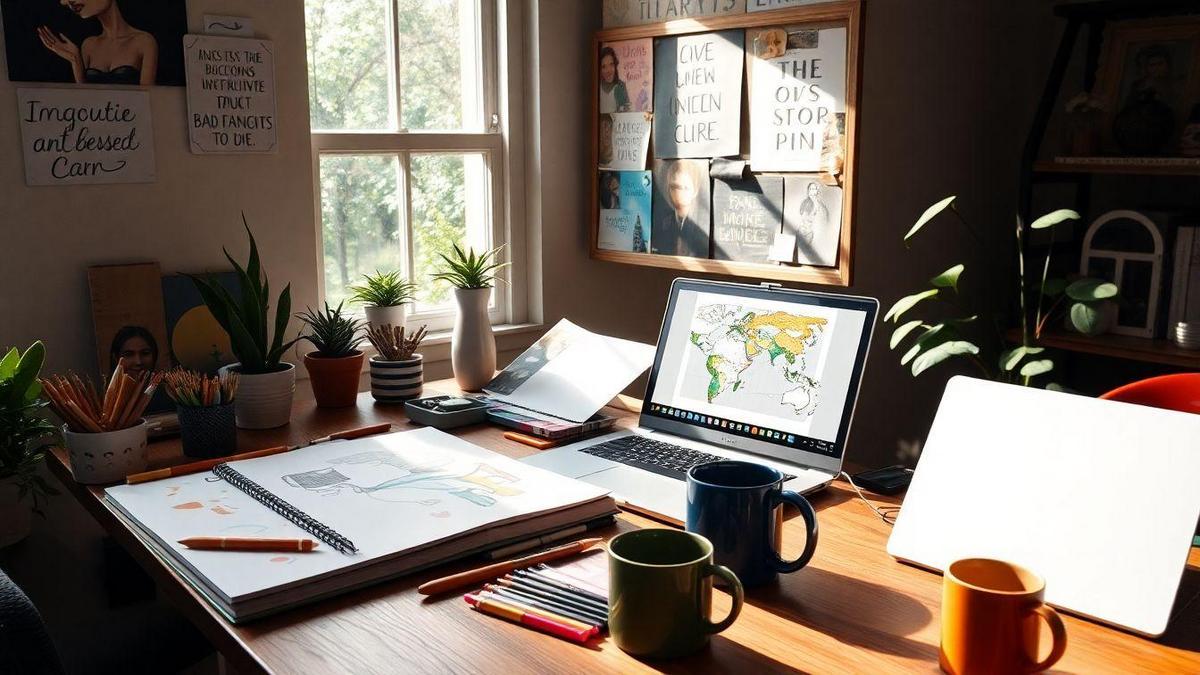As a creative worker, I know that productivity enhancement techniques for remote workers in creative fields can make a huge difference in my daily grind. I want to share my journey on how I manage my time and stay focused. From scheduling my day to brainstorming ideas, I’ll reveal the tools and strategies that help me enhance my productivity and keep those creative juices flowing. Let’s dive into my world of effective time management and get those creative sparks igniting!
Effective Time Management Strategies for Creative Workers
The Importance of Scheduling My Day
When I think about my day, I realize that scheduling is like creating a map for my journey. Without a map, I might wander aimlessly, wasting precious time. By plotting out my day, I ensure I stay on track and hit my goals. Having a clear plan helps me focus on what truly matters. It’s my secret weapon for boosting my productivity.
How I Use Time Blocks to Stay Focused
One of the best strategies I’ve found is using time blocks. This means I set specific chunks of time for different tasks. For example, I might dedicate one hour to writing, another hour to brainstorming, and so on. This method keeps me from getting distracted.
Here’s how I break it down:
| Task | Time Block |
|---|---|
| Writing | 9:00 AM – 10:00 AM |
| Brainstorming | 10:15 AM – 11:15 AM |
| Editing | 11:30 AM – 12:30 PM |
| Lunch | 12:30 PM – 1:00 PM |
| Client Calls | 1:15 PM – 2:15 PM |
By using time blocks, I can concentrate fully on one task at a time. It’s amazing how much I can accomplish!
Tips for Creating a Daily Schedule
Creating a daily schedule doesn’t have to be complicated. Here are a few tips that have worked wonders for me:
- Start with Priorities: List what needs to be done first. This helps me focus on the most important tasks.
- Be Realistic: I avoid overloading my schedule. I know I can only do so much in a day.
- Include Breaks: I make sure to add short breaks. They help me recharge and come back refreshed.
- Review and Adjust: At the end of the day, I look back at what I accomplished. If something didn’t go as planned, I adjust for the next day.
By sticking to these tips, I’ve seen a noticeable improvement in my productivity enhancement techniques for remote workers in creative fields.
Creative Brainstorming Techniques to Boost Productivity
My Favorite Methods for Idea Generation
When I think about boosting my creativity, a few methods always come to mind. These techniques help me generate fresh ideas and keep my mind sharp. Here’s what I love to do:
- Free Writing: I set a timer for 10 minutes and write nonstop. It’s amazing how many ideas spill out when I don’t worry about grammar or structure.
- Word Association: I pick a random word and write down everything that comes to mind. This often leads to unexpected connections.
- Group Brainstorming: Sometimes, I gather friends or colleagues. The energy is electric, and bouncing ideas off each other often leads to brilliant insights.
How I Use Mind Mapping to Organize Thoughts
Mind mapping has become my go-to tool for organizing ideas. It’s like creating a visual web of thoughts. Here’s how I do it:
- Start with a Central Idea: I write my main topic in the center of a page.
- Branch Out: I draw lines to subtopics and ideas that relate to the main topic. This helps me see connections clearly.
- Use Colors and Images: I add colors and doodles to make it visually appealing. This keeps my mind engaged.
By using mind mapping, I can see the big picture and the details all at once. It’s a game-changer for keeping my thoughts organized.
Tools That Help Me Brainstorm Effectively
To make my brainstorming sessions even more productive, I rely on a few handy tools:
| Tool | Purpose |
|---|---|
| Trello | Organizing tasks visually |
| Miro | Collaborative mind mapping |
| Evernote | Storing ideas and notes |
| Google Docs | Real-time collaboration |
These tools help me stay on track and keep my ideas flowing. They are like my trusty sidekicks in the world of creativity!
Goal Setting for Artists to Enhance Productivity
Why I Set SMART Goals for My Projects
When I think about my projects, I always lean towards SMART goals. These goals are Specific, Measurable, Achievable, Relevant, and Time-bound. This approach helps me stay focused and clear about what I want to achieve. For example, instead of saying, “I want to paint more,” I say, “I will complete three paintings by the end of the month.” This clarity gives me a roadmap to follow.
How I Track My Progress and Stay Motivated
Tracking my progress is like having a personal cheerleader. I use a simple spreadsheet to keep tabs on my goals. Here’s how I do it:
| Goal | Start Date | End Date | Progress |
|---|---|---|---|
| Complete 3 paintings | 01/01/2023 | 01/31/2023 | 2 out of 3 |
| Attend 2 workshops | 01/01/2023 | 06/30/2023 | 1 completed |
Every time I check off a box, I feel a rush of motivation. It’s like climbing a mountain; each step gets me closer to the top. I also reward myself when I hit milestones. Maybe it’s a treat or a day off. This keeps the fire burning!
The Role of Accountability in Achieving My Goals
Accountability is my secret sauce. I share my goals with a friend or fellow artist. When I know someone is checking in on me, I feel more driven. It’s like having a workout buddy; we push each other to do better. I also join online groups where we share our progress. This community support keeps me on my toes and reminds me that I’m not alone in this journey.






